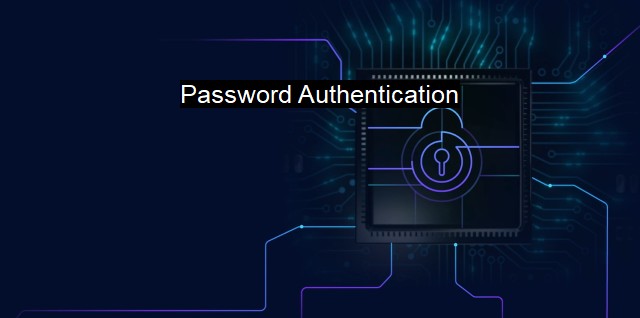What is Password Authentication?
The Power of Password Authentication: Best Practices and Importance for Cybersecurity and Data Protection
"Password authentication" is a widely utilized verification method within the domain of cybersecurity and antivirus software, designed to uphold the integrity, confidentiality, and availability of systems, networks, and data. Authentication is a quintessential process to validate a user's identity before accessing any computer system or online account. In this context, the password serves as a 'key' that confirms credentials to grant authorized access to specific resources or services. It is virtually akin to the physical key that we use to unlock doors and lockers.The methodology inherent within password authentication is hinged on knowledge-based authentication systems, which revolves around 'something you know'. Passwords are confidential details that are assumed to be known only by the user, ensuring exclusive access to the authenticated systems. They work within a system framework, incorporating algorithms that convert them into some form of encrypted data or 'hash'. This converted data becomes virtually unreadable, which further safeguards the original password's security. Whenever users input their passwords, the system compares the resultant hash with the recorded hash. If there is a match, it signifies a successful authentication process, and the user gains access.
Relying on password authentication for cyber security necessitates regularly updated strong, longer and unique passwords. They should ideally be a judicious mix of numbers, symbols, punctuation marks, uppercase, and lowercase letters. Security advisors recommend against the usage of simplistic passwords, using personal foundational information or recycling one password across several different platforms for convenience. Consequently, hacking such weak passwords becomes an easy feat for malicious intruders. Strong passwords, with their inherent complexity and uniqueness, make unauthorized break-ins arduous for hackers, preserving the confidentiality and integrity of data stored in systems.
Many applications in antivirus and other cybersecurity services employ password authentication procedures to secure resources and detect rogue attempts. For instance, antivirus software typically integrates a password-protected configuration, where passwords prove necessary to remove, modify, or disable the antivirus software. This feature thwarts attempts to tamper with the software by unauthorized users. Similarly, firewalls, Virtual Private Networks (VPNs) and cloud security components may also use password-based verification to manage authorized accesses and privileges.
Password authentication is not infallible and has certain insecurities. Passwords can be leaked, forgotten, stolen, cracked, or bypassed under various circumstances. passwords increasingly fall prey to several types of attack strategies, such as Keylogging attacks, dictionary attacks, brute force, or rainbow table attacks. These attack techniques can reveal passwords and abuse authenticated system accesses required for controlling systems and breaching confidential data—a dire cyber security concern.
To address these vulnerabilities, password authentication is subsequently complemented by Multi-Factor authentication methods or advanced User Behavior Analytics (UBA), offering additional security layers. They integrate a combination of verification mechanisms involving ‘something you have’ like a mobile or a token, and ‘something you are’—biometric traits—fingerprint, iris scanning, facial or voice recognition, thus heightening the complexity for attackers attempting unauthorized access.
Password authentication is an integral aspect of cybersecurity and antivirus applications. It serves as the frontline defense against unauthorized intrusion and data breaches. it must also be evolved and fortified with more robust and multi-tiered authentication strategies to ensure an error-proof, fool-proof cybersecurity framework given the escalating advancements in malicious hacking and intrusion methodologies. Thus, fostering high-levels of password security and wisely integrating advanced authentication methods are vital in building robust cybersecurity applications and promoting safe digital practices.

Password Authentication FAQs
What is password authentication?
Password authentication is a security measure that requires users to enter a password to gain access to a system or application. It verifies the user's identity and prevents unauthorized access to sensitive information.How does password authentication work?
Password authentication works by comparing the user-entered password with a previously stored password or hash value. If the two values match, the user is granted access. If the values do not match, access is denied.What are some best practices for password authentication?
Some best practices for password authentication include using strong, complex passwords, frequently changing passwords, avoiding using the same password for multiple accounts, and enabling multi-factor authentication. Additionally, it's important to keep passwords confidential and not share them with others.What are some common vulnerabilities associated with password authentication?
Some common vulnerabilities associated with password authentication include weak passwords that are easily guessed, passwords that are reused or shared among multiple accounts, and passwords that are not changed frequently. Additionally, hackers may use tactics like phishing or malware to steal passwords or gain unauthorized access to systems.| | A | | | B | | | C | | | D | | | E | | | F | | | G | | | H | | | I | | | J | | | K | | | L | | | M | |
| | N | | | O | | | P | | | Q | | | R | | | S | | | T | | | U | | | V | | | W | | | X | | | Y | | | Z | |
| | 1 | | | 2 | | | 3 | | | 4 | | | 7 | | | 8 | | |||||||